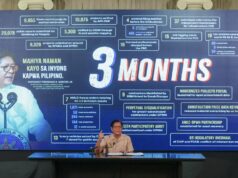The Third Telco Project, Winner’s Curse and Sustainability
The government’s third telco project managed by the DICT seems on the verge of naming the lucky winner of the third player race based on the highest committed level of service (HCLoS) involving price and internet speed. The winner will operate within a narrow corridor of performance: it has to offer faster internet service at the same or at a lower price than currently on offer. The winner shall have posted a performance bond of P14 billion which will be forfeited if its performance falls below committed levels. It will then have to spend P40 billion in the first year and P240 billion in the succeeding five years. Among the committed indicators is the allocation of the capital spending: 40% for operating expenditure, 20% for broadband and 40% for national coverage. By Nov. 7 at 10 a.m., we will know the lucky winner. Or will the prize be a “winner’s curse”?
A “winner’s curse” usually applies to auction outcomes where the bidders overestimate the present value of the asset under auction, overbid and the eventual winner pays much more than what the asset is worth. This is common in spectrum auctions where the asset under auction is a share of the electromagnetic spectrum. The true value of the spectrum depends upon the size and growth of the cellphone market which has inherent uncertainty attached to them. The bidding of the 3G radio spectrum in 2000 using the Vickrey or second price sealed bid auction raised astronomical revenues for European governments (£22.5 billion in the UK, e.g.). The overpaying winner defaults on its bid and the final harvest is a loss for all. Dominant cable operator NTL (National Transcommunication, Ltd.) in the UK failed its bid and sought Chapter 11 bankruptcy protection in 2002.
The DICT rejected the open auction preferred by the Department of Finance in favor of HCLoS. But HCLoS remains a tournament with the bid parameter being the highest committed level of service instead of the giveback to the government, as was in the auction for CALAX. One recalls that the PNoy government realized P28 billion giveback from the CALAX rebid and some people wondered whether Metro-Pacific fell into a winner’s curse. The HCLoS bidders could also overestimate the present value of the extra spectrum on offer and the market demand and bid too low a service price for a given internet speed which can translate into future financial losses. This will also be effectively a winner’s curse and can lead to default, forfeiture of the bond and dislocation.

One cannot tell in advance with any accuracy whether a winner’s curse has resulted because it is an uncertainty gamble. When Manila Water won the East Side concession for water service in Metro Manila at P2.31/m3, some people thought Manila Water stumbled into a winner’s curse. But Manila Water made it work, while Maynilad — which started with a P4.96/m3 for the West Side concession — stumbled and the concession was sold to another company.
I am not privy to the details of the contract that the winner and the government will eventually ink but there will be surefire differences with the water concession contract. The water concessionaires were, in their own franchise area, true monopolists and are regulated by MWSS. The third telco will form a triopoly with the incumbents. The capital spending of the incumbents will not be subject to a floor like that of the entrant. And their capital allocation will not be circumscribed like the entrant’s. The entrant cannot presumably raise capital in the stock market where stocks are anonymously traded; since it may that way end up owned by the incumbent telcos. It is expected to expand coverage, presumably where the incumbents are absent. The absence of incumbents means that the unserved markets are unprofitable and thus would mean financial loses for the entrant. These strictures make for costly rigidities for the entrant. It is expected to compete in the same footing in the market with the incumbents but it starts with a handicap.
The impact of the third telco on consumer welfare depends upon the extent of the collusive behavior in the extant duopoly market and on the new efficiencies the third telco introduces. A third telco parleying a newer lower cost technology will exert competitive pressure on the incumbents but how much no one knows. This much we know. First, we know that San Miguel Corp. sat on a franchise owned by a subsidiary Vega Telecoms of the 700 MHz spectrum for six years before it was sold to the incumbents. A potential third telco player, especially one already owning a franchise and one with the financial clout of San Miguel Corp., should have already exerted a competitive pressure on incumbents to improve services. This is a variant of the effect of an extant “competitive fringe.” Although the collapse of the partnership with Telstra may have prompted the sale, a better explanation may be that the risk-weighted returns did not justify the investment in a market that had plumbed the depths of tingi-tingi. Second, the Philippines already had a triopoly in the past when Sun Cellular entered in 2001 and introduced unlimited call and text services. That prompted the two incumbents to offer a similar suite of services. But Sun Cellular itself could not sustain its early momentum and sold out to PLDT Smart. Third, in the 1990s, there were even more telco companies but which consolidated into two today. One can view this consolidation as a sinister rent-seeking conspiracy but it could just be scale and network economies. What if the current duopoly is a “natural duopoly,” in which case more than two firms is unsustainable?
Raul V. Fabella is a retired professor of the UP School of Economics and a member of the National Academy of Science and Technology. He gets his dopamine fix from hitting tennis balls with wife Teena and bicycling.



